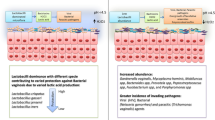Abstract
High vaginal swabs (HVS) of 1792 expectant mothers were sent for culture at the time of delivery, prior to first vaginal examination. The newborns were followed-up for development of superficial or deep infections. Appropriate cultures of the babies who developed infections were sent. Bacterial growth of predominantly gram-ve organisms was obtained in 1026 (57%) HVS. Infection developed in 48 (27%) babies in 1 st 72 hours of life, of which 28 had deep infection while the rest had superficial infection. Vertical transmission of organisms was documented in 24 (1.3%) mother—baby dyads and the same was 72% in newborns who were at risk of developing sepsis by septicemia scoring, showing a significantly higher incidence of vertical transmission and subsequent sepsis in high risk newborns.
Similar content being viewed by others
References
Beargie R, Lynd P, Tucker E, Duhring J. Perinatal infection and vaginal flora.Am J Obstet Gynecol 1975; 122: 31–33.
Hosmer ME. Screening method for identification of infected infants.Pediatrics 1972; 49: 283–286.
Tucker VP, Bhakoo ON. Scoring system for prediction of early neonatal infection.Indian Pediatr 1974; 11: 597–601.
Kishore K, Deorari AR, Singh M, Bhujwala RA. Early onset neonatal sepsis, vertical transmission from maternal genital tract.Indian Pediatr 1987; 24: 45–48.
Bhatia BD, Chugh SP, Narang P. Bacterial flora of pregnant women at admission in maternity wards.Indian Pediatr 1986; 23: 17–20.
Ross J. Perinatal implication of lower genital tract flora.Perinatal Infection. CIBA symposium 1980; 69: 77–80.
Udani RH, Vaze S, Roys M, Paul SS. Premature rupture of amniotic membranes and neonatal infection—Pridecetive value of bacteriologic culture from different sites.Indian J Pediatr 1980; 47: 137–140.
Galark RP, Larson B, Ohm MJ. Vaginal flora and its role in disease entities.Clin Obstet Gynecol 1976; 19: 61–81.
Klein JO, Remington JS. Infections acquired by the newborn infant during birth. In: Remington JS, Klein JO. eds.Current concepts of infections of the fetus and newborn infant, in infectious disease of fetus and newborn infant. Third edition London: Saunders, 1991: pp 11–12.
Karpuch J, Goldberg M, Kohcleol D. Neonatal bacterimia—A 4-years prospective study.Isr J Med Sci 1983; 19: 963–966.
Bada HS, Alojipan LC, Andrews BF. Premature rupture of membranes and its effect on the newborn.Pediatr Clin North Am 1977; 24: 491–500.
Chaturvedi P, Agrawal M, Narang P. Analysis of blood culture isolate from a rural hospital.Indian Pediatr 1989; 26: 460–465.
Sharma PP, Haldar D, Dutta AK et al. Bacteriological profile of neonatal septicemia.Indian Pediatr 1987; 24: 1011–1017.
Author information
Authors and Affiliations
Rights and permissions
About this article
Cite this article
Ayengar, V., Madhulika & Vani, S.N. Neonatal sepsis due to vertical transmission from maternal genital tract. Indian J Pediatr 58, 661–664 (1991). https://doi.org/10.1007/BF02820186
Issue Date:
DOI: https://doi.org/10.1007/BF02820186



